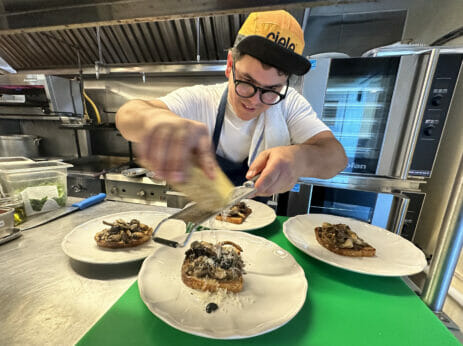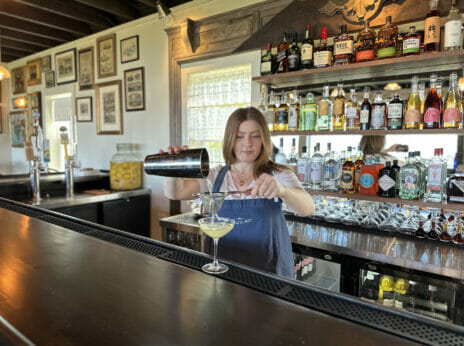Andrea Tese grew up fishing with her grandfather. Now, she’s hoping to spread her message of ocean conservancy through, of all things, a seafood restaurant.

Photographer Andrea Tese was always looking for a hook to promote ocean conservancy. Growing up on the North Fork of Long Island, she spent her summers fishing for snapper off a bridge with her grandfather. Tese shared his passion for the ocean. “Ever since I can remember, all I wanted was to be in the water. I would live for family trips to the Caribbean where I got to explore multicolored bustling reefs. Now, they are blanched ghost towns.” Tese has seen the disappearance and drastic shifts across the ocean, and especially close to home. The once-famous Peconic Bay scallops have been nearly decimated in recent years.
As a photographer, Tese has tried to document the changing ocean life, both to preserve a memory of what once was and to bring attention to its rapid decline. In December 2019, after years of trial and error, she finally perfected an innovative 8×10 sheet film camera, designed to take underwater photographs of the Channel Islands’ kelp forests. Tese wanted a unique way to tell the story of the plight of the integral kelp forests. Then, the pandemic struck, the dive boats were docked and her visual storytelling was put on indefinite hold.
That’s when Tese decided to spread her message of ocean conservation another way: through a seafood restaurant.

Chef Cheo Avila at Minnow. Photography by Michelle Colman.
Yes, it seems unorthodox or even counter-intuitive at first glance, but Tese is approaching the foodservice industry with resolve to shake things up. Minnow will only serve responsibly line or trap caught seasonably available seafood. The restaurant’s motto is: Local. Line caught. Organic. Despite being told by “almost everyone” that her business model is impossible (mostly due to cost and sourcing), Tese is determined to prove them all wrong. “Absolutely no nets, no draggers, trawlers, gill or seine nets,” she vows. “And, absolutely no bykill.”
“Bykill” or “bycatch” are terms used for animals accidentally caught in fishing gear. Nets do not discriminate. Whatever is not intended to be caught is discarded. It is estimated that the U.S. discards two billion pounds of bycatch a year. According to Gen V, “About 40 percent of fish caught worldwide are captured unintentionally and are either thrown back dying or left to die on the boat.” Bycatch can include whales, dolphins, sea turtles, sea birds, coral and sharks. The negative effects of bycatch go far beyond the unnecessary deaths of unintentional catches, disrupting the entire marine ecosystem.
The difficulties of only serving locally sourced, responsibly caught seafood extend beyond trying to find local fishermen in line with Minnow’s mission. Tese continues her extensive research of the fishermen’s methods and also takes into consideration where the fish are processed.
Cognizant of the locals’ way of life, Tese asks detailed questions, such as what kind of lines are used to catch which fish? “Certain fish caught on long lines can be bad depending on where those lines are so they don’t catch the wrong animals,” says Tese.“Golden tilefish can only be caught on long lines, but those lines are very deep down so no other marine animals get caught on them.”
Similarly, she says, the majority of seafood processing plants in the country have closed due to the economic development potential of waterfront property and cheaper offshore options. Even if consumers think they are getting “local” fish, that fish is often frozen, shipped to China for processing, thawed, processed, refrozen and returned. “And,” says Tese, “who is to say that you even get the same fish back?”
Rather than take her chances with foreign processors, Tese is determined to stick with local seafood, and she is pleased with the diversity of options. Her Mediterranean-inspired menu will include golden tilefish, black sea bass, which is plentiful around the North Fork, porgy and raw bar items such as whelks, local lobsters, squid and blue claw crabs, as well as local produce and wine.

Amanda Akran curated the bar and cocktail menu for Minnow. Photography by Michelle Colman.
Beyond the sustainable menu, Tese aims to use only reusable or returnable glass to-go containers, mismatched thrifted tableware sets and vintage decor reworked by Lumber & Salt from its local salvage yard.
Tese hopes to host fundraising events and talks to benefit her favorite conservancy nonprofits, such as Oceana and Sea Shepherd, at least twice a year. “That is the way I’ll educate people.” However, she has no intention of being heavy handed with her conservation message, as she believes the proof is in the pudding. “If I can prove the model works, it will speak for itself.”
Minnow opened recently on Memorial Day weekend in the waterfront town of New Suffolk.